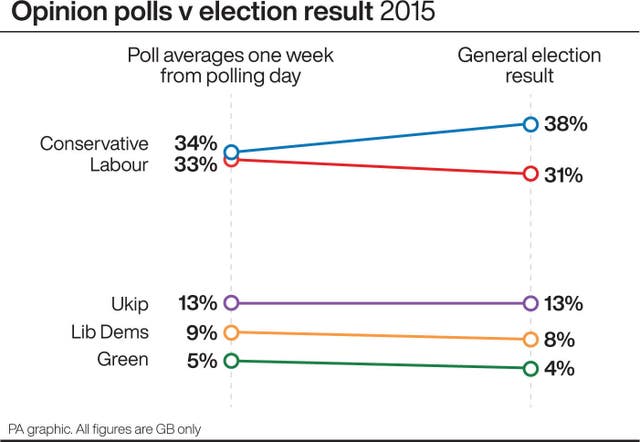
Just one week from today, millions of people across the country will be voting in the General Election.
Opinion polls continue to suggest the Conservative Party enjoys a comfortable lead over Labour.
The latest poll averages put the Tories on 43%, with Labour on 33%, the Liberal Democrats on 13%, the Brexit Party on 3% and the Greens on 3%.
But what are the chances of the polls shifting decisively between now and election day?
 (PA Graphics)
(PA Graphics)
At this point in the 2017 election campaign, the polls showed the Conservatives on 44%, with Labour on 35%, the Lib Dems on 8%, Ukip on 4% and the Greens on 2%.
READ MORE: Labour accused of failing to investigate antisemitism cases
But on election day, the Tories finished on 43% – one point below where they had been a week earlier – while Labour had risen six points to 41%.
The Lib Dems were still on 8%, while both Ukip and the Greens finished on 2%.
The change was enough to deny the Tories a majority and produce a hung parliament.
 (PA Graphics)
(PA Graphics)
There was movement in 2015 as well, albeit on a smaller scale and with different consequences.
One week before polling day in 2015, the Tories were averaging 34% and Labour 33%, with Ukip on 13%, the Lib Dems on 9% and the Greens on 5%.
These figures pointed to a hung parliament – but come election day, the Tories opened up a seven-point lead over Labour to finish on 38% while Labour ended on 31%.
READ MORE: Jo Swinson suggests she will not work with SNP for People's Vote if 'price tag' is indyref2
Ukip, the Lib Dems and Greens finished on 13%, 8% and 4% respectively.
This was enough to give the Conservatives a small overall majority in Parliament.
 (PA Graphics)
(PA Graphics)
The pattern in 2015 and 2017 suggests that what the polls are showing one week from election day is not necessarily the best guide to what will happen on election day itself.
It also serves as a reminder that polls are not predictions, merely snapshots of opinion at a certain point in time.
– All figures quoted above are for vote shares in Great Britain



Why are you making commenting on The Herald only available to subscribers?
It should have been a safe space for informed debate, somewhere for readers to discuss issues around the biggest stories of the day, but all too often the below the line comments on most websites have become bogged down by off-topic discussions and abuse.
heraldscotland.com is tackling this problem by allowing only subscribers to comment.
We are doing this to improve the experience for our loyal readers and we believe it will reduce the ability of trolls and troublemakers, who occasionally find their way onto our site, to abuse our journalists and readers. We also hope it will help the comments section fulfil its promise as a part of Scotland's conversation with itself.
We are lucky at The Herald. We are read by an informed, educated readership who can add their knowledge and insights to our stories.
That is invaluable.
We are making the subscriber-only change to support our valued readers, who tell us they don't want the site cluttered up with irrelevant comments, untruths and abuse.
In the past, the journalist’s job was to collect and distribute information to the audience. Technology means that readers can shape a discussion. We look forward to hearing from you on heraldscotland.com
Comments & Moderation
Readers’ comments: You are personally liable for the content of any comments you upload to this website, so please act responsibly. We do not pre-moderate or monitor readers’ comments appearing on our websites, but we do post-moderate in response to complaints we receive or otherwise when a potential problem comes to our attention. You can make a complaint by using the ‘report this post’ link . We may then apply our discretion under the user terms to amend or delete comments.
Post moderation is undertaken full-time 9am-6pm on weekdays, and on a part-time basis outwith those hours.
Read the rules here